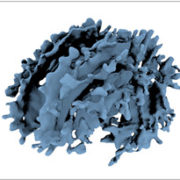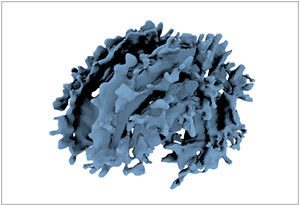
Using a mass spectrometer, Yetrib Hathout, Ph.D., is able to quantify 3,000 to 4,000 proteins from a tissue sample to identify proteins associated with cancer.
Using a Somascan proteomics assay – which simultaneously analyzes 1,129 proteins in a small volume of serum – a team led by Children’s National Health System researchers identified 21 biomarkers that respond to corticosteroids taken daily by children with Duchenne muscular dystrophy (DMD) and inflammatory bowel disease.
Corticosteroids are commonly prescribed to treat inflammatory conditions. High daily doses of corticosteroids are considered the standard of care for DMD, a type of muscular dystrophy characterized by worsening muscle weakness that affects 1 in 3,600 male infants. However, depending on the age of the child and drug dosage, chronic use is associated with such side effects as changes in bone remodeling that can lead to stunted growth, weight gain, facial puffiness caused by fat buildup, mood changes, sleep disturbances, and immune suppression. The research team sought to identify blood biomarkers that could be leveraged to create a fast, reliable way to gauge the safety and efficacy of corticosteroid use by children. The biomarkers also could guide development of a replacement therapy with fewer side effects.
“Ten pro-inflammatory proteins were elevated in untreated patients and suppressed by corticosteroids (MMP12, IL22RA2, CCL22, IGFBP2, FCER2, LY9, ITGa1/b1, LTa1/b2, ANGPT2 and FGG),” Yetrib Hathout, Ph.D., Proteomic Core Director at Children’s National, and colleagues write in the journal Scientific Reports. “These are candidate biomarkers for anti-inflammatory efficacy of corticosteroids.”
The blood biomarkers sensitive to corticosteroids fit into three broad groups, according to the authors. The children taking corticosteroids were matched with children of the same age who had never taken the medicine. Five biomarkers significantly increased in this corticosteroid-naïve group and decreased in kids prescribed corticosteroids. The biomarkers generally were inflammatory proteins and included chemokine, insulin-like growth factor binding protein 2, and integrin alpha-I/beta-1 complex.
The second group of biomarkers included nine proteins associated with macrophage and T-lymphocytes that were significantly reduced in concentration in kids taking corticosteroids. According to the study, this finding hints at corticosteroids blunting the ability of the immune system’s most able fighters to respond to infection.
In the third group were five proteins that were significantly increased by corticosteroid treatment in DMD and included matrix metalloproteinase 3, carnosine dipeptidase 1, angiotensinogen, growth hormone binding protein, insulin, and leptin, a hormone linked to appetite.
What researchers learned with this study will help them more accurately design the next phase of the work, Hathout says.
“We are the first team to report a number of novel discoveries, including that growth hormone binding protein (GHBP) levels increase with corticosteroid use. This represents a candidate biomarker for stunted growth. In order to use that new information effectively in drug development, the next studies must corroborate the role of serum GHBP levels as predictors of diminished stature,” he adds. “The study finding that four adrenal steroid hormones are depressed in kids taking corticosteroids raises additional questions about the broader impact of adrenal insufficiency, including its role in the delay of the onset of puberty.”
This work was supported by National Institutes of Health grants (R01AR062380, R01AR061875, P50AR060836, U54HD071601, K99HL130035, and R44NS095423) and Department of Defense CDMRP program grant W81XWH-15-1-0265. Additional support was provided by AFM-Telethon (18259) and the Muscular Dystrophy Association USA (MDA353094).











